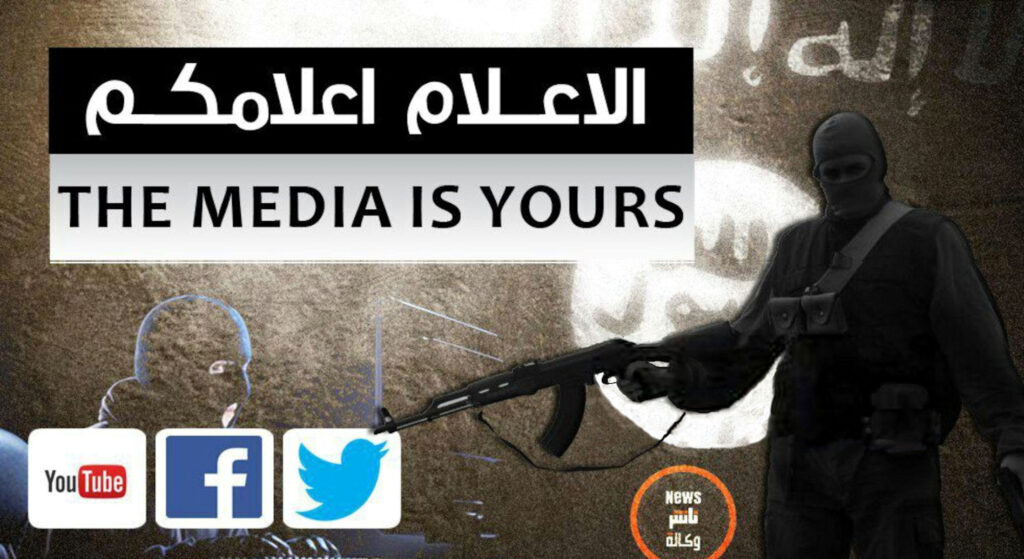Islamic Jihadist social media lessons teach marketers how to get around take-downs. In today’s cancel culture jihadist groups are remarkably immune to getting de-platformed. The “caliphate” may be defeated, but marketing by various violent extremist and jihadist groups is as robust as it ever has been. Despite robust efforts to “take it down,” Islamist content online is growing. These groups have been highly successful in reaching and influencing their market against bigger challenges than any brand marketer faces. Here is some insight into how ISIS and the lesser known, but more innovative Hay’at Tahrir al-Sham (see Vanity Fair on jihadist social media techniques) do it.
Marketing as Warfare for Jihadists
Al Qaeda leader Ayman al-Zawahiri acknowledges the power of marketing communications and media in a letter to ISIS founder Abu Musab al-Zarqawi: “The media jihad against the enemy is no less important than the material fight against it.” ISIS actively recruits “media operatives” to fight in “media platoons,” using “media weapons” that are “more potent than atomic bombs.” Social media plays a crucial role in the “electronic ribat” network of jihadist marketing strongholds.
Networks of Influence
Dr. Ali Fisher, a specialist networks of influence and in methods of achieving influence across a range of disciplines, including public diplomacy and strategic communication, counter-terrorism, child protection, human security, and public health, has published with several colleagues* this remarkable analytic series that contain important Islamic jihadist social media lessons for any marketer:
- Mapping the Jihadist Information Ecosystem: Towards the Next Generation of Disruption Capability
- The Call-up: The Roots of a Resilient and Persistent Jihadist Presence on Twitter
- Tweeting for the Caliphate: Twitter as the New Frontier for Jihadist Propaganda
- How well established is the Jihadist movement on Telegram?
- Swarmcast: How Jihadist Networks Maintain a Persistent Online Presence
Jihadist Social Media Innovations
What Dr. Fisher’s analysis shows is that Islamic jihadists are adept at innovating ways to use technology to get their messages out no matter how much effort goes into trying to stop them. Here are some innovations that marketers should note:
- Multi-platforming: These groups use more than one platform, employing each in ways to exploit their different strengths. They then cross-link them into a dynamic network. The group Shumukh al-Islam with ties to both al Qaeda and ISIS, published “Dalil Twitter” a guide outlining the role of Twitter among various platforms and identified five different types and roles of accounts. Other guides explain jihadist use of other platforms and how they work together in the multi-platform strategy.
- Sharing: Many marketers spend most of their effort on posting content. These groups don’t make that mistake. They spend at least half their energy in encouraging sharing, endorsing, re-publishing and re-purposing—efforts that massively magnify reach and impact. The Twitter guide mentioned above provided links to 66 different Arabic-language accounts as source materials to share and amplify. It is easy to see the exponentially fast and vast reach of jihadist marketing messages.
- Beaconing: Part of the multi-platform strategy divides platform roles. Some platforms act as hosts of content and other platforms act as “beacons” to reach people and send traffic back to host platforms. No matter how fast companies take down jihadist content, enough beacons remain that content can always still find its audiences.
- Swarmcasting: This “netwar” technique uses dispersed individuals in massive numbers in self-organized, interconnected, dynamic “swarm” attacks that broadcast content fast and far so that censors cannot really take it down.
As groups like ISIS lose territory, their struggle moves increasingly into the sphere of marketing communication. Despite its losses, ISIS has actually increased its marketing output. These groups learn quickly and are early adopters of technology. Among the most important Islamic Jihadist social media lessons is to constantly probe for weaknesses and loopholes to exploit. We can expect jihadists to use low tech work-arounds and eventually to harness artificial intelligence and bots to keep their marketing many steps ahead of censors and their content right in front of their audiences.
* Nico Prucha and Emily Winterbotham
